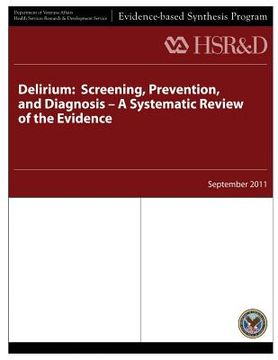Delirium: Screening, Prevention, and Diagnosis - A Systematic Review of the Evidence (en Inglés)
Reseña del libro "Delirium: Screening, Prevention, and Diagnosis - A Systematic Review of the Evidence (en Inglés)"
This review was undertaken to evaluate the effectiveness of screening for delirium in adult inpatients, the effectiveness of strategies employed to prevent delirium in acute elderly inpatients, and the comparative diagnostic accuracy of tools used to detect delirium in elderly medical, surgical, and ICU patients. For this review, we were careful to make the important distinction between screening for delirium (testing all patients for delirium without a prior index of suspicion) and diagnosis of delirium (testing those patients for whom there is already some suspicion of delirium). Delirium is a common syndrome, characterized by the acute onset of altered mental status, hallmarked by difficulty sustaining attention and a fluctuating course, and frequently causing patients, families, and health care providers considerable distress. There have been wide variations in the reported incidence of delirium in medical inpatients, largely due to differences in setting, patient population, and methodology. It has been estimated that 10-30% of patients admitted to the hospital develop delirium; this percentage can increase significantly in at-risk populations, including frail elderly patients (estimated at 60%), post-surgical elderly patients (estimated as high as 89%), or ICU patients (estimated at 41%). Delirium has been associated with multiple serious outcomes in medically ill patients, including increased morbidity, length of stay, healthcare costs, institutionalization, and mortality. Delirium is often significantly under-recognized by healthcare providers and can frequently be difficult to resolve. Several brief "bedside" questionnaires and checklists exist that can detect delirium earlier and among those with milder symptoms. Efforts to prevent the development of delirium in those at risk have been advocated. Medications (including sedatives, narcotics, and anticholinergic drugs), diseases and intercurrent illnesses (e.g., stroke, infection, shock, anemia), surgical procedures (especially orthopedic and cardiac surgery), and environmental factors (e.g., use of a bladder catheter, pain, and emotional stress) are all precipitating factors for delirium development. Therefore, identifying and implementing effective strategies to prevent and detect delirium could improve clinical outcomes and resource utilization. Suggested strategies to prevent delirium include avoidance of psychoactive medications, pharmacologic interventions to decrease risk, and single- or multi-component non-pharmacologic interventions (including use of music, mobilization, fluid and nutrition management, and orientation and cognitive stimulation). The final key questions are: 1. What is the effectiveness of screening for delirium in adult inpatients? a. Do these results vary by medical unit, age, gender or comorbid conditions? b. Does screening for delirium improve clinical outcomes? 2. What are the effectiveness and harms of delirium prevention strategies in acute elderly inpatients? a. Do these results vary by medical unit, age, gender or comorbid conditions? 3. What is the comparative diagnostic accuracy of the tools used to detect delirium: a. In elderly medical and surgical inpatients? b. In elderly medical or surgical intensive care unit (ICU) inpatients?

